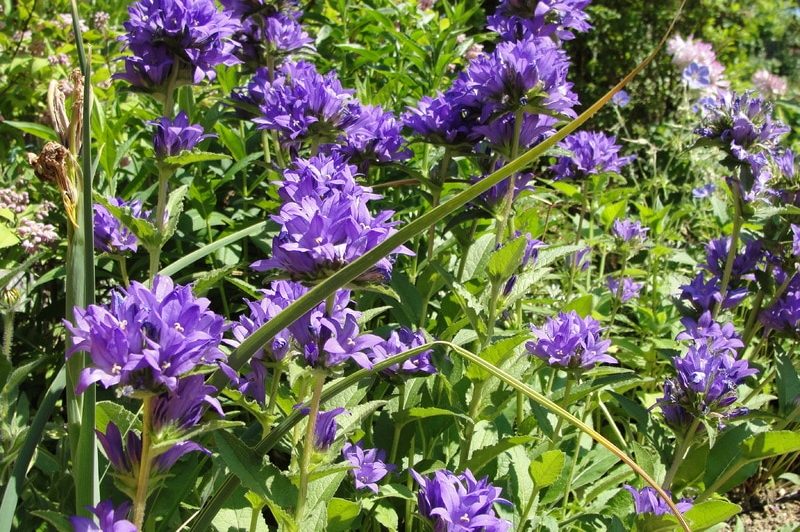There are two solutions to master if you want to know how to get rid of campanula. In some cases, deadheading is not enough to control campanula. Some gardeners might also find these plants in their garden and affect their landscape negatively.
Campanula is likely to be a native plant in your region, and it can be a headache to control them if left unbothered for too long. However, the two solutions below should help you manage these plants. You can also consider growing in the greenhouse to make the prevention of native plants more comfortable.

Comprehensive Guide On How To Get Rid Of Campanula
Method #1. Prevention and control
The first option to get rid of campanula is doing the preventative and management practices for these plants. Understanding these techniques will help you slow down their growth and even prevent their development for easier removal in the long run. Remember that it’s not enough only to remove campanulas with herbicides, but you must also control and manage them.
Seedling removal
To start, remove the new seedlings manually as soon as you notice them on the ground. Campanulas have a distinct heart-shaped cluster of leaves as their seedlings, and you can remove them by hand with the help of a trowel. Campanulas can produce up to 15,000 seedlings in a year, so regular removal and checking are necessary to eliminate them completely.
Root removal
Besides the seeds, campanulas also spread via their roots. They come in the form of fleshy underground roots with the fibrous parts close to the ground surface. To ensure that you have removed the roots altogether, dig around 6 inches into the ground when removing mature campanulas.
You might think that pulling campanula plants is of no value, but the idea behind this eradication technique is that you prevent reseeding and further developing the plants. Remember that removing the deeper roots will prevent new growth, and addressing the plants while still small makes them more manageable. You can also cover small patches with newspaper and then pour soil and mulch over them to smother the campanula plants.
Method #2. Herbicides
Removing the seedlings and roots of campanulas will help you control their population and growth much more comfortably. However, you may benefit from also using herbicides if the plants are too many and too difficult to remove manually. Understandably, not all gardeners are comfortable in handling chemicals, especially in the garden, but you can safely use glyphosate and dicamba to get rid of campanulas.
Glyphosate vs dicamba
The former herbicide is useful when fall is about to start to help slow down the growth of campanulas. However, do note that glyphosate itself will kill other types of grasses as well. Therefore, you can only use it for specific areas using a brush or carefully targetting the plants.
On the other hand, dicamba does not pose a risk to other types of grasses. But regardless of what herbicide you use, you must follow the label directions diligently to avoid problems and drawbacks. It would help if you also researched the safe yet effective interval schedule suitable for removing campanulas.
You also want to check the chemicals and avoid 2,4-D as campanulas are already resistant to this chemical. Once you have chosen the herbicide, aim to apply them in late spring or at the start of fall to ensure that the conditions support the chemicals. The day shouldn’t be windy or rainy, so the plants have enough time to contact the herbicide.
Where Does Campanula Grow Best?
To further help you eradicate and control campanulas, you have to understand their ideal growing conditions. Perhaps you can grow your plants in the greenhouse to make these plants’ management easier than growing them outdoors. If the area is not supportive of campanula growth and development, it will be easier to eliminate them.
Remember that campanulas are native to some areas and will be more likely to become invasive species in your garden. In general, these so-called invasive species such as Campanula latifolia and Campanula takesimana will thrive best in moist conditions. Be mindful of the irrigation and drainage in your area while also keeping the climate in mind.
Most campanula varieties are also self-sowing, and this is a factor that you must keep in mind. The conditions that support campanula seed germination are no different from other plant seeds. Perhaps the control you can do here is by preventing the development of the seed capsules themselves and remove the faded flowers.
Conclusion
Gardening can sometimes present unwelcomed plants in the area, including campanulas. While they are beautiful flowers, it’s useful to know how to get rid of campanula, especially when they are overcrowding the space and affecting the other plants. After all, an untidy garden is not only an eyesore, but it also opens the opportunity for pests and diseases.
You can always monitor the location and remove the seedlings and roots of campanulas to lessen their numbers. This will help you get rid of them quicker instead of getting overwhelmed by the foliage. Then, you can do a spot treatment with glyphosate or a broad treatment with dicamba.
